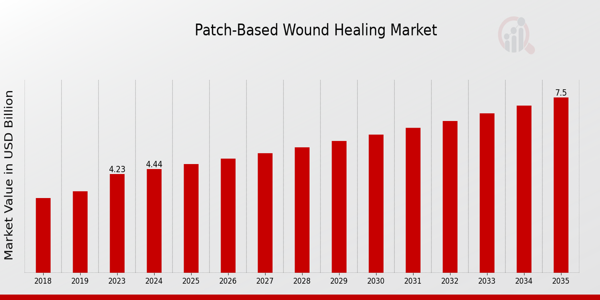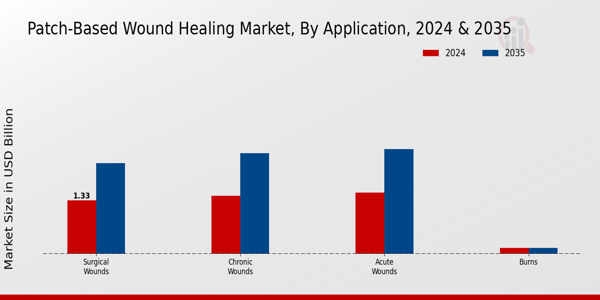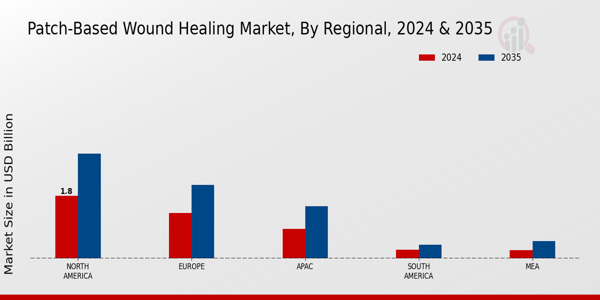Patch-Based Wound Healing Market Overview
The Patch-Based Wound Healing Market Size was estimated at 4.23 (USD Billion) in 2023. The Patch-Based Wound Healing Industry is expected to grow from 4.44(USD Billion) in 2024 to 7.5 (USD Billion) by 2035. The Patch-Based Wound Healing Market CAGR (growth rate) is expected to be around 4.88% during the forecast period (2025 - 2035).
Key Patch-Based Wound Healing Market Trends Highlighted
Some market engines or trends greatly influence the growth of the Global Patch-Based Wound Healing Market. The high and rising rate of wound incidences is especially of concern, as wound types may range from chronic wounds such as diabetic foot ulcers and pressure sores to others. Furthermore, the increasing number of surgical procedures and traumatic injuries has increased the number of patients that require effective advanced wound care technology. Patients and even healthcare professionals have become more conscious and concerned about the management of wounds, fueling the market further. These smart materials coupled with technological advancements such as the inclusion of antibacterial elements in the patch-based solutions improve effectiveness and attractiveness of the products in many clinical environments.
There are plenty of gaps in the market that businesses can fill on order to achieve growth. The shift in focus towards personalized medicine provides an opportunity for specialized wound care products designed for best healing outcomes. With the adoption of modern wound care practices from developing economies, there is also shifting population base that is largely unreached. Partnerships with clinics and other healthcare organizations can help in the education and publicity of advanced wound care management, increasing the market size. At the moment, there is a clear movement towards the integration of digital health tools into therapeutic and surgical wound management.
Mobile applications and telemedicine solutions are being developed and integrated for monitoring the progress of wound healing as well as providing care from a distance which is increasing the convenience level of both patients and caregivers. The emergence of bioengineered wound dressings that leverage the physiological healing process itself is proving to be both fascinating and a new solution to age old problems in wound management. Given the current pace of these developments, it is quite evident that these trends will profoundly determine the future of the Global Patch Based Wound Healing Market.

Source: Primary Research, Secondary Research, MRFR Database and Analyst Review
Patch-Based Wound Healing Market Drivers
Increasing Incidence of Chronic Wounds and Surgical Procedures
One of the most significant drivers fueling the growth of the Global Patch-Based Wound Healing Market Industry is the rising incidence of chronic wounds and the increasing number of surgical procedures performed annually. As the global population continues to age, the prevalence of conditions such as diabetes, obesity, and venous diseases rises, leading to a higher number of chronic wounds that require specialized wound care management. Additionally, surgeries, although they have become safer due to advancements in medical technology, still carry risks of complications that can lead to postoperative wounds.
The growing recognition of the need for effective wound management solutions to improve healing rates and reduce the risk of infections is driving demand for innovative patch-based wound healing products. This shift towards specialized treatments over traditional methods is reshaping healthcare practices and emphasizing the role of advanced wound care products in achieving better patient outcomes. The Global Patch-Based Wound Healing Market Industry is poised for substantial growth as healthcare providers are increasingly embracing these products, thereby contributing to the expanding market landscape.Moreover, the ongoing research and development in materials and technologies used for patch-based wound healing products offer promising prospects for future innovations, further stimulating market growth.
Technological Advancements in Wound Care Management
Technological advancements have a profound impact on the Global Patch-Based Wound Healing Market Industry, enhancing the efficacy and efficiency of wound care management. Integration of smart technology into wound care products provides real-time monitoring of the healing process, allowing healthcare professionals to assess and modify treatment plans based on specific patient needs. New materials and designs are being developed that promote faster healing, minimize pain, and reduce the likelihood of infections.These innovations are transforming traditional wound management practices and are critical drivers for the market as healthcare providers increasingly favor advanced products with greater clinical benefits.
Rising Demand for Advanced Wound Care Products
The growing awareness and demand for advanced wound care products strongly contribute to the expansion of the Global Patch-Based Wound Healing Market Industry. Patients and healthcare professionals are increasingly recognizing the benefits of utilizing specialized wound dressings and patches that not only promote quicker healing but also ensure better infection control and comfort. As the healthcare landscape shifts towards patient-centered care, there is a heightened focus on providing effective solutions capable of managing a diverse range of wound types.This trend is encouraging manufacturers to innovate and expand their product lines to meet the evolving needs of the healthcare sector.
Patch-Based Wound Healing Market Segment Insights
Patch-Based Wound Healing Market Application Insights
The Global Patch-Based Wound Healing Market, particularly within the Application segment, has demonstrated considerable growth and diversification, contributing significantly to the overall industry landscape. As of 2024, the Application segment of the market encompasses various critical areas, including Surgical Wounds, Chronic Wounds, Acute Wounds, and Burns, with notable valuations of 1.33 USD Billion, 1.44 USD Billion, 1.52 USD Billion, and 0.15 USD Billion, respectively. Among these, the Surgical Wounds category holds a prominent position, indicating a significant portion of the market, primarily due to the increasing number of surgical procedures globally.The Chronic Wounds category also plays an important role, driven by the rising prevalence of diabetes and obesity, which are major contributors to chronic wound conditions.
Furthermore, Acute Wounds are vital in this market as they arise from trauma and accidents, representing a growing need for effective healing solutions in emergency and outpatient settings. Burns, albeit valued at a smaller 0.15 USD Billion in 2024, still requires specialized treatment, maintaining relevance within the market but reflecting a niche segment. As the market evolves, trends highlight a growing inclination towards innovative and efficient patch-based solutions that cater to the specific requirements of each wound type, enhancing patient outcomes and recovery times.The Global Patch-Based Wound Healing Market segmentation showcases the importance of addressing diverse wound healing needs through tailored products, underscoring opportunities for growth driven by advancements in technology and materials. The anticipated market growth suggests that stakeholders should closely monitor these distinct categories to leverage their respective potential within the Global Patch-Based Wound Healing Market data, thereby aligning their strategies with market dynamics to ensure sustained engagement and success in this evolving landscape.

Source: Primary Research, Secondary Research, MRFR Database and Analyst Review
Patch-Based Wound Healing Market Product Type Insights
The Global Patch-Based Wound Healing Market is projected to reach a valuation of 4.44 billion USD by 2024, exhibiting a steady growth trajectory. This market demonstrates significant diversity within different product types, including Hydrocolloid Dressings, Alginate Dressings, Foam Dressings, and Transparent Film Dressings. Hydrocolloid Dressings are particularly popular for their ability to maintain a moist environment, promoting faster healing, while Alginate Dressings are valued for their high absorbency, making them ideal for exuding wounds.Foam Dressings dominate due to their cushioning properties and comfort, which are vital in daily wear, particularly for chronic wounds. Transparent Film Dressings are often employed for their ability to provide a protective barrier while allowing for breathability and visibility. The evolving preferences toward advanced wound care solutions are driving substantial market growth, as each product type addresses specific patient needs and diverse wound care scenarios.
Patch-Based Wound Healing Market End Use Insights
The Global Patch-Based Wound Healing Market focuses significantly on the End Use segment, which encompasses various healthcare settings, including hospitals, ambulatory surgical centers, and home care product. In 2024, the overall market is expected to be valued at approximately 4.44 billion USD, illustrating strong demand across these settings. Hospitals play a crucial role in this market, often requiring advanced wound healing solutions due to the high volume of surgical procedures and patient care. Ambulatory surgical centers are becoming increasingly important, offering efficient outpatient care with less complexity, leading to greater patient satisfaction.Home care is also gaining traction, driven by the rising need for at-home management of chronic wounds, enabling better patient recovery at their convenience. The growth in these areas is supported by a rising aging population and an increase in chronic illnesses, thus showcasing the evolving landscape of the Global Patch-Based Wound Healing Market. Alongside these factors, challenges such as potential product recalls and regulatory scrutiny could influence market dynamics, while opportunities for innovative product development and digital health integration provide avenues for further growth within the Global Patch-Based Wound Healing Market industry.
Patch-Based Wound Healing Market Material Type Insights
The Global Patch-Based Wound Healing Market reflects a significant evolution, with a projected valuation of 4.44 billion USD by 2024 and an expected rise to 7.5 billion USD by 2035. This growth trajectory can be partly attributed to advancements in material types utilized for wound healing, which include Biodegradable Materials, Synthetic Polymers, and Natural Polymers. Biodegradable materials are gaining traction due to their environmentally friendly attributes and reduced need for surgical removal, making them a preferred option in modern healthcare.Meanwhile, synthetic polymers remain vital in this landscape due to their versatility and enhanced control over mechanical properties, allowing for designs tailored to specific healing requirements. Natural polymers, on the other hand, are significant for their biocompatibility and wound healing properties, thus catering to market needs for products that align with biological tissues. Overall, the segmentation of the Global Patch-Based Wound Healing Market illustrates a dynamic interplay among these materials, each contributing to the industry’s growth by addressing diverse consumer needs and preferences within wound care solutions.The market's continuous evolution presents various opportunities and challenges, driven by technological advancements and changing regulatory landscapes.
Patch-Based Wound Healing Market Regional Insights
The Global Patch-Based Wound Healing Market is poised for significant growth across various regions, with the market projected to reach a valuation of 4.44 USD Billion in 2024. North America leads the market, accounting for 1.8 USD Billion, representing a majority holding due to its advanced healthcare infrastructure and high adoption of innovative wound care technologies. Europe follows closely with a valuation of 1.3 USD Billion, highlighting its strong focus on research and development in wound care. The APAC region is emerging rapidly, valued at 0.85 USD Billion, driven by increasing healthcare access and rising patient awareness.South America and MEA are comparatively smaller markets, valued at 0.25 USD Billion and 0.24 USD Billion, respectively, in 2024, but they present significant opportunities for growth as healthcare systems in these regions continue to evolve. Overall, the regional segment showcases diverse growth dynamics influenced by local healthcare policies, economic conditions, and technological advancements, driving the demand for patch-based wound healing solutions globally.

Source: Primary Research, Secondary Research, MRFR Database and Analyst Review
Patch-Based Wound Healing Market Key Players and Competitive Insights
The Global Patch-Based Wound Healing Market has witnessed significant advancements and innovation driven by a growing demand for effective wound management solutions. Various companies are competing to enhance their product offerings through research and development while also focusing on expanding their geographical presence. The competitive landscape is characterized by the introduction of advanced technologies that improve the healing process, which is essential in catering to a diverse range of patients, including those with chronic wounds, surgical wounds, and burns. Additionally, partnerships and collaborations between firms are common strategies deployed to consolidate market share and enhance distribution networks, allowing for a stronger footprint in both emerging and established markets.Johnson and Johnson holds a prominent position in the Global Patch-Based Wound Healing Market, leveraging its extensive experience and expertise in the field of healthcare. The company's strengths lie in its comprehensive range of wound care products that provide effective solutions for various wound types. Johnson and Johnson's commitment to research and innovation enables it to develop cutting-edge technologies that improve patient outcomes and expand its product offerings.
The brand's strong reputation and established distribution channels worldwide significantly contribute to its market presence. By continually investing in the development of new and advanced patch-based solutions, Johnson and Johnson remains competitive and maintains a trusted relationship with healthcare providers, ensuring that its products meet the evolving needs of patients and wound care practitioners alike.Acelity has established itself as a key player in the Global Patch-Based Wound Healing Market, renowned for its specialized wound care solutions. The company's strengths primarily revolve around its innovative product portfolio, which includes advanced wound dressings designed to promote optimal healing environments. Acelity's focus on research and development has led to the introduction of various innovative technologies in wound management, further enhancing its competitive edge. This firm also benefits from strong strategic collaborations with healthcare professionals and institutions, allowing for continuous feedback that informs product development. Acelity's commitment to improving patient care through specialized solutions makes it a formidable competitor in the patch-based wound healing space, ensuring that it stays at the forefront of industry advancements and meets the diverse needs of healthcare facilities globally.
Key Companies in the Patch-Based Wound Healing Market Include:
- Johnson and Johnson
- Acelity
- WoundKair
- Integra LifeSciences
- Hollister Incorporated
- Coloplast
- Smith and Nephew
- Advancis Medical
- Bayer
- 3M
- Convatec
- HillRom
- Medtronic
- Derma Sciences
Patch-Based Wound Healing Market Industry Developments
Recent developments in the Global Patch-Based Wound Healing Market have highlighted significant advancements and strategic movements among leading companies. Johnson & Johnson has been enhancing its product line, focusing on innovative wound care solutions. Acelity and 3M are also making strides through new product launches aimed at improving patient outcomes and driving technological advancements. Moreover, a notable trend is the consolidation within the market, with companies like Smith & Nephew and Convatec actively pursuing acquisition opportunities to broaden their market reach. The increase in mergers and acquisitions is indicative of the dynamic nature of the industry, with companies looking to leverage synergies for growth and expansion. Companies such as Integra LifeSciences and Medtronic are investing heavily in research and development, seeking to capitalize on the rising demand for advanced wound care solutions. Market valuation growth is reflected in the strategic partnerships and collaborations formed to address the evolving needs in wound management, which is driving competition and innovation in the sector. The ongoing technological advancements and heightened focus on chronic wound care continue to shape the market landscape, indicating robust growth potential for the industry in the coming years.
Patch-Based Wound Healing Market Segmentation Insights
Patch-Based Wound Healing Market Application Outlook
- Surgical Wounds
- Chronic Wounds
- Acute Wounds
- Burns
Patch-Based Wound Healing Market Product Type Outlook
- Hydrocolloid Dressings
- Alginate Dressings
- Foam Dressings
- Transparent Film Dressings
Patch-Based Wound Healing Market End Use Outlook
- Hospitals
- Ambulatory Surgical Centers
- Home Care
Patch-Based Wound Healing Market Material Type Outlook
- Biodegradable Materials
- Synthetic Polymers
- Natural Polymers
Patch-Based Wound Healing Market Regional Outlook
- North America
- Europe
- South America
- Asia Pacific
- Middle East and Africa
| Attribute/Metric Source: |
Details |
| MARKET SIZE 2023 |
4.23(USD Billion) |
| MARKET SIZE 2024 |
4.44(USD Billion) |
| MARKET SIZE 2035 |
7.5(USD Billion) |
| COMPOUND ANNUAL GROWTH RATE (CAGR) |
4.88% (2025 - 2035) |
| REPORT COVERAGE |
Revenue Forecast, Competitive Landscape, Growth Factors, and Trends |
| BASE YEAR |
2024 |
| MARKET FORECAST PERIOD |
2025 - 2035 |
| HISTORICAL DATA |
2019 - 2024 |
| MARKET FORECAST UNITS |
USD Billion |
| KEY COMPANIES PROFILED |
Johnson and Johnson, Acelity, WoundKair, Integra LifeSciences, Hollister Incorporated, Coloplast, Smith and Nephew, Advancis Medical, Bayer, 3M, Convatec, HillRom, Medtronic, Derma Sciences |
| SEGMENTS COVERED |
Application, Product Type, End Use, Material Type, Regional |
| KEY MARKET OPPORTUNITIES |
Growing geriatric population, Rising incidence of chronic wounds, Advancements in wound care technology, Increased awareness of wound management, Expanding healthcare infrastructure in emerging markets |
| KEY MARKET DYNAMICS |
Rising prevalence of chronic wounds, Growing geriatric population, Advancements in wound healing technologies, Increasing demand for efficient dressings, Expansion of healthcare infrastructure |
| COUNTRIES COVERED |
North America, Europe, APAC, South America, MEA |
Frequently Asked Questions (FAQ) :
The Global Patch-Based Wound Healing Market is expected to reach a value of 7.5 USD Billion by 2035.
The market is projected to exhibit a CAGR of 4.88% from 2025 to 2035.
North America is expected to have the largest market share, valued at 3.0 USD Billion by 2035.
The market value for Surgical Wounds is projected to reach 2.25 USD Billion by 2035.
Major players include Johnson & Johnson, Acelity, WoundKair, Integra LifeSciences, and Hollister Incorporated.
The market for Chronic Wounds is expected to reach 2.5 USD Billion by 2035.
The market for Acute Wounds is projected to be valued at 2.6 USD Billion by 2035.
The APAC region is anticipated to reach a market value of 1.5 USD Billion by 2035.
The market for Burns is expected to maintain a value of 0.15 USD Billion by 2035.
The MEA region is expected to grow to a market value of 0.5 USD Billion by 2035.

















